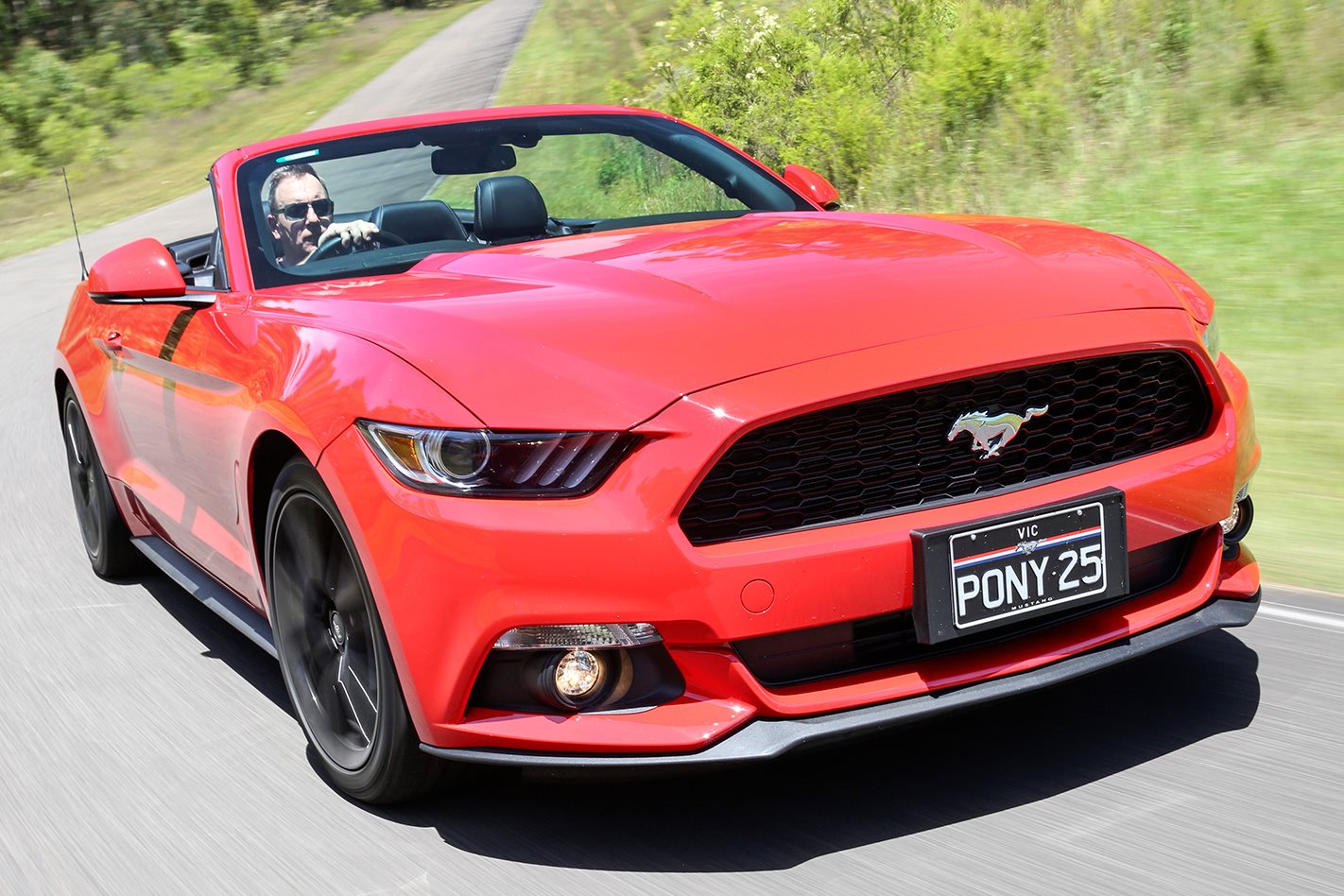How do the first proper right-hand drive Mustangs hold up in Oz? And should you join the queue to ride home in one?
WHAT IS IT? The first US-factory-built right-hand-drive iteration of Ford’s iconic pony car. It has a nameplate that’s been in constant production since 1964, but only previously had two official Australian releases in 52 years. Now, after high anticipation, the all-new generation is finally here in Oz after delays relating to the supply of right-hand drive specific manifolds.
WHY ARE WE TESTING IT? It’s our first chance to properly assess this all-important halo car for Ford in Australian spec, on Aussie roads, and to find out how successful the product planners have been in delivering a cohesive line-up of body styles, engine choices and transmission pairings. And to make a value call.
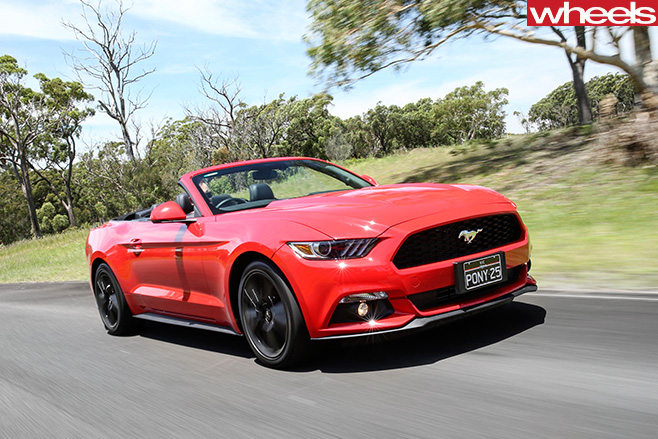
PLUS: Knockout styling; generous grip; fine dynamics; sane pricing MINUS: Very firm ride, Convertible not ultra-rigid, both engines need to be louder
THE WHEELS REVIEW THE only potential problem with a growing wave of anticipation and expectation is the chance it can crash against the rocks of reality, leaving a trail of disappointment and a forlorn chorus of “is that it?”
Few cars have risked this as much as the new Mustang: it’s been one of the most hyped and anticipated cars in recent years. We’ve cheerfully been a part of that, deeming it cover-worthy on three occasions since January 2014, and devoting some 27 pages to it over the same period.
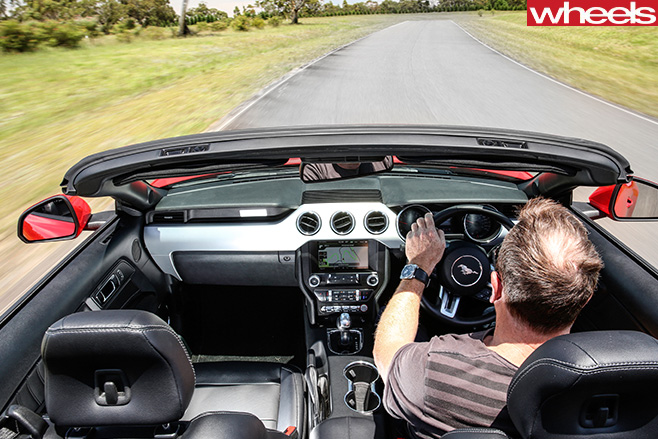
But is it brilliant? A true Blue Oval game changer? Well, let’s not get ahead of ourselves…
We learned from Road Test Editor Nathan Ponchard’s Stateside drive late in 2014 that it’s a car brimming with character and the kind of desirability that only comes when you’ve officially hit icon status. What wasn’t completely clear was how specifics of suspension tune, wheel and tyre combinations and right-hook configuration would translate to Aussie roads. Finally we have those answers.
But first, have a look at the thing. Seriously. If the way to a man’s heart is through his stomach, then surely the thoroughfare to a car enthusiast’s main aorta is via the eyeballs. A performance car needs to seduce you visually before it charms the pants off you with dynamic prowess.
On this score, the Mustang lands a direct hit. This is a brilliant reinterpretation of the original’s design language – a squinty-eyed, bulging-haunched head kicker that creates a sweet harmony out of tension and aggression. The artful sculpting of the bonnet bulge is a thing to behold, both as you approach the driver’s door and from inside the car. The taillights, comprising vertical LED bars inside slotted Perspex blades, are a gorgeous nod to the ’68 Fastback coupe. Punters honk, wave and shout approval. That’s life in the icon lane.
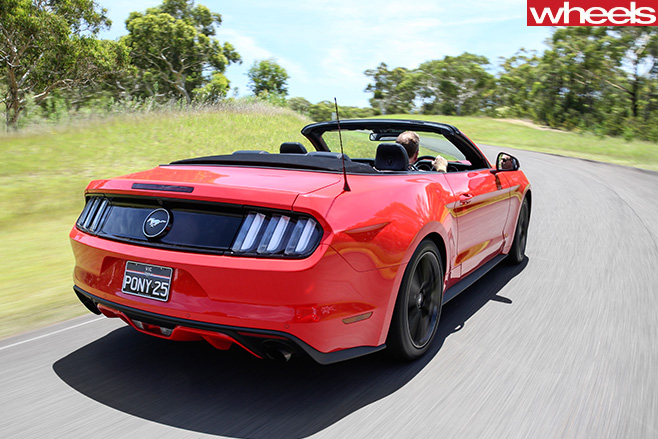
Roof up, the Convertible loses the elegant roofline sweep of the coupe, serving up more of a notch-back profile that, to my eye, is a lot less desirable.
In the interests of working up the range, we start off in what I’d respectfully suggest is the least blokey variant, an auto convertible powered by the engine expected to take only around 10 percent of initial sales, the 2.3-litre Ford Mustang Ecoboost four. Fed by a twin-scroll turbo, it makes a peak of 233kW, with max torque of 432Nm at 3000rpm. But 90 percent of this torque peak is available at just 1720rpm, so it’s terrifically eager, not too boosty-feeling if you select the Normal drive mode, and doesn’t shy from being worked hard.
In fact, it needs to be whipped along to let you get you involved. Below around 4500rpm, it’s too quiet and a bit characterless, despite the (questionable) inclusion of a sound symposer set-up that pipes engine noise through the audio speakers. Pull the shifter back into the Sport mode and get stuck in and there’s ample enjoyment to be had, with the auto holding the lower of its six ratios right up against the 7000rpm limiter and ample, rorty, sound filling the cabin. It’s a curious note, not typically turbo four-pot. It’s more warbly and slightly out of phase, like someone’s dangled a mic near something with Cosworth on the cam covers.
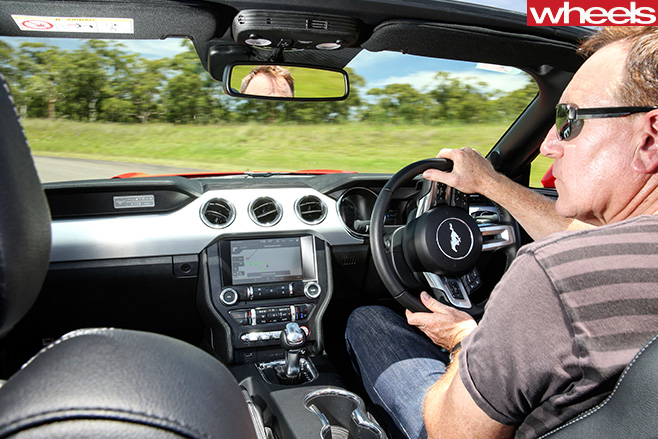
It should be explained at this point that all Australian-spec cars come standard with a variation of the optional Performance Pack offered in the US, part of which includes stiffer springs, firmer dampers and thicker anti-roll bars. This seems questionable on the Convertible, given the target market, because this combo surely contributes to the slightly too-reactive ride, along with the steady flow of minor tremors that ripple through the body and see the rear-view mirror quivering away busily over anything less than glassy bitumen.
Open-road cruising is perfectly pleasant, though, even if the absence of any wind-management system does mean a fair degree of swirling, disturbed air in the cabin at freeway speed. Cruise mode also allows our attention to be drawn to a few misses in the right-hook cabin execution. The indicator stalk is on the right-hand side but the centre console remains unchanged, meaning the handbrake is located next to the passenger, and the deep bottle holders leave your beverages sticking up right where your arm needs to be to change gears in manual models. Better to drink in the mostly agreeable retro ambiance, admire the real aluminium that clads the instrument panel, and try to ignore some of the cheaper switch gear and hard plastics.

The throttle tips in with total precision, the V8 snarls via proper induction ducting piped from behind the dash, not the aural smoke and mirrors of the four-pot, and the medium-weighted clutch bites with mush-free progression. Only an excess of driveline shunt mars the manual experience. There’s a dull thud with each first-to-second shift that sounds like fat man being kicked in the bum, which could get tiresome in traffic. The shift action has a nice mechanical feel; the gates themselves are tightly spaced. And what a pleasure to be connected to a linear, eager, atmo V8.
The manual coupe’s 0-100 time is nothing to sneeze at, but on the road the performance feels swift rather than holy-crap fast. That’s more a product of the twin-turbo grunt-monster world in which we now live than any real shortcoming of the V8, although its quoted outputs are down a bit compared to LHD cars (largely a matter of divergent measuring standards). The important thing is there’s ample power to get the most out of a cracking chassis.

Front brakes on the GT Fastback are whopper Brembos clamped by six-piston calipers, and while the initial pedal action feels too sensitive and over-servoed, they bite hard and feel capable of withstanding a proper pounding.
So, for many customers, an auto four-pot convertible at $54,990 could be all the Mustang they really need, even if it may not be the Mustang they really want. The entry-level manual Ecoboost Fastback, at $45,990, is really just dangled as showroom bait, while the value equation of the V8 Convertible (auto only at $66,490) starts to head south. That leaves the choice between GT Fastback manual ($57,490) and GT Fastback auto ($59,990).
Either way, expect that wave to be one of delight, not disappointment.
SPECS Model: Ford Mustang GT Fastback Engine: 4951cc V8 (90), dohc, 32v Max Power: 306kW @ 6500rpm Max Torque: 530Nm @4250rpm Transmission: 6-speed automatic Kerb weight: 1747kg 0-100km/h: 4.8sec (claimed) Fuel economy: 12.6 L/100km Price: $59,990 On sale: Now


